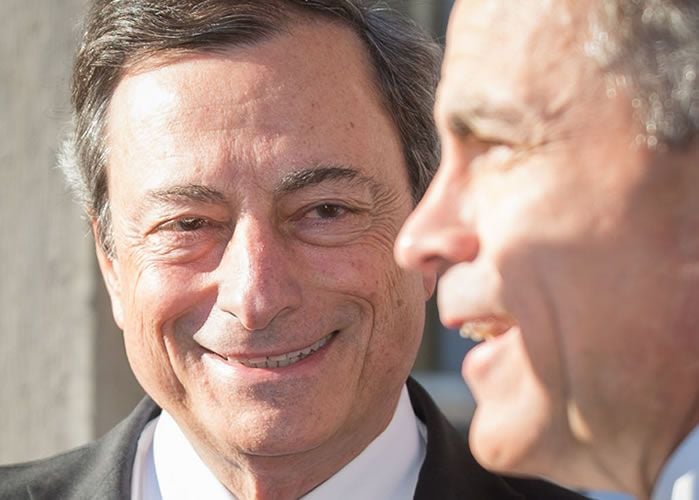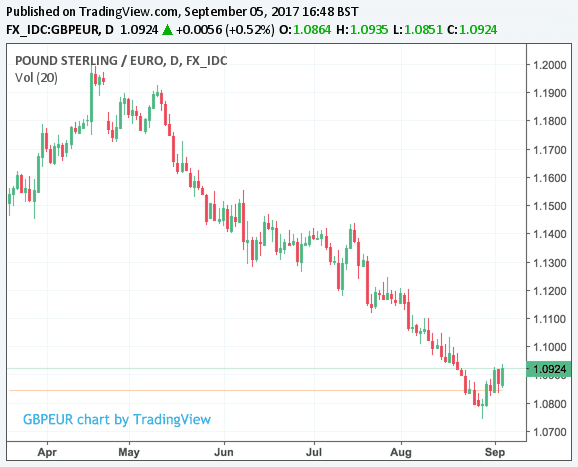Pound-to-Euro: Better Rates Ahead as Central Banks Tipped to Set the Tone this Month
- Written by: James Skinner
-
"Although the ECB can dampen the Euro via its communication, it would have limited tools to turn the tide" - Nick Kounis, ABN Amro.

Above: Mario Draghi, President of the ECB and Mark Carney, Governor of the Bank of England are two figures that matter for currency markets this September. (C) European Central Bank.
Central banks are likely to set the tone for both Pound Sterling and the Euro over coming weeks; and according to a number of analysts, this offers the GBP/EUR exchange rate potential relief.
While Brexit remains the central issue for Sterling and the UK economy, it will likely be the Bank of England which will be of more importance over coming weeks and there is the chance that the current period of consolidation in the GBP/EUR exchange rate might extend and potentially give way to better levels for Euro buyers.
This is the view of foreign exchange analyst Viraj Patel with ING Bank N.V. in London who is also watching for signals from the European Central Bank as he believes the two central banks are key to the exchange rate’s near-term evolution.
Sterling has been caught in an entrenched downtrend against the Euro for since May and it reached an eight-year nadir at 1.0750 in late August. Recent weakness has since been realisted, partly on the back of investor nerves as to what the ECB intends to do at its September 7 policy meeting.

De-Facto Cap on the Euro's Advance
That the ECB is key to the Euro’s near-term outlook should come as no surprise to those watching FX markets; the September and October meetings have long been flagged as being pivotal as the question of the withdrawal of monetary stimulus will be addressed.
An attempt to influence the Euro into giving back some of its recent gains is widely expected from the ECB in its policy statement, due Thursday, while expectations are building that the Bank of England might attempt to push the Pound higher by adopting a slightly hawkish tone the following week.
“We believe that some caution by the ECB this week over an over-exuberant EUR - coupled with greater BoE concerns over GBP-induced inflation next week - could provide a de-facto cap on EUR/GBP upside around the 0.92-0.93 area,” says Viraj Patel, a foreign exchange strategist at ING.
A 0.9300 pence ceiling for the EUR/GBP exchange rate means a floor of 1.0750 and ceiling of 1.0870 for the GPB/EUR exchange rate.
So Patel is not looking for a significant recovery, rather stabilisation.
The call is not unique and is a theme we have been reporting on at Pound Sterling Live over the past week or so; a number of analysts have suggested the Pound’s fall against the Euro is looking overextended and might be due a reversal.
The EUR/GBP pair has gained more than 7% for the year-to-date and, although quoted at 0.9191 at the start of this week, it has been as high as 0.9305 in the last seven days.
Get up to 5% more foreign exchange by using a specialist provider by getting closer to the real market rate and avoid the gaping spreads charged by your bank for international payments. Learn more here.
It’s About Inflation
At the centre of the central bank story is the impact recent currency moves are having on inflation in both the UK and the Eurozone.
In the UK, inflation has risen sharply and rises further with every incremental fall in the value of the pound.
In July inflation was seen at 2.6%, well above the Bank of England’s 2.0% target, the Bank anticipate the rate to creep a little further towards 3.0% before reversing. Signs of inflationary pressures are certainly abating, but another step lower in the value of Sterling risks igniting the uptrend in inflation once more and taking it above 3.0%.
The Bank’s mandate is to control inflation, and this might mean raising rates to support Sterling.
Eurozone inflation is meanwhile seen at 1.5% in August; well below the ECB’s 2.0% target.
A rising Euro tends to put downward pressure on imported inflation so the ECB faces the opposite problem to the BoE and has an interest in quelling the Euro’s rise.
“The size of the downward revisions to their staff inflation forecast could surprise investors, introducing downside risks for EUR,” say currency analysts at Barclays in a briefing to clients which suggests the updated inflation forecasts released by the ECB could hold the key to future trade in Euros.
As such, the incentive for the ECB to talk the Euro lower are elevated.
“The bigger driver for EUR/GBP this week will be the ECB meeting and whether President Draghi has the desire - and verbal firepower - to drive the EUR lower,” Patel at ING notes, adding that it would take a threat to delay the tapering of its bond buying programme in order to force the Euro sustainably lower.
But, if the ECB fails to mention the Euro, consider a positive upside reaction.
“A further risk for the currency would stem from a lack of comment on the recent EUR strength, suggesting that the ECB is willing to look through further appreciation,” say Barclays.
This could reignite the Euro's rally against Sterling and press the GBP/EUR exchange rate down to fresh eight-year lows.
Beware Hawks at the Bank of England
Although strategists at ING are watching for a more hawkish-sounding Bank of England, economists elsewhere are already predicting the bank will look to hike rates over the coming quarters - instead of simply talk.
This will play well for Sterling.
“Brexit is not enough to keep rates on hold: the short-term risks following the Brexit vote have not manifested in a serious way....we look for a first rate hike in November 2017,” writes Berenberg’s senior UK economist, Kallum Pickering, in a recent note.
Talk of a possible rate hike at the Bank of England comes at a time when UK economic growth has slowed, negotiations over Britain’s withdrawal from European Union appear to have stalled and politicians in Westminster are taken up with a dispute over whether to pass a bill designed to facilitate as seamless a departure from the political block as possible.
But Berenberg’s Pickering believes the Bank of England’s work is done and that, with post-crisis monetary policy having achieved all that it can, support for the economy is now the work of politicians.
Others are also forecasting a rate hike from the BoE but not quite so soon.
“We have pushed back the timing of the first rate increase from the BoE from November to February 2018 following the Quarterly Inflation Report release… that suggested to us that the BoE will need a little more time before being confident enough to alter policy,” says Derek Halpenny, European head of global markets research at MUFG, in a note Friday.
The ECB will announce its monetary policy decision on Thursday, September 07 at 12:45 London time while the Bank of England will take centre stage the following Thursday, 14 September. The Federal Reserve will announce its latest policy decision on September 20.
“Although the ECB can dampen the Euro via its communication, it would have limited tools to turn the tide in the case of – for instance – a more significant bout of dollar or sterling weakness,” says Nick Kounis, head of financial markets research at ABN Amro.
Pound Outperforming on Technical Considerations
The British Pound is one of the best performing currencies in the global G-10 complex on Tuesday, September 5.
The currency was seen advancing against both the Dollar and Euro amidst suggestions that markets are being driven by technical considerations at present.
“The technical rebound of sterling took a breather yesterday but resumed today,” says analyst Piet Lammens at KBC Markets in Brussels.
UK data didn’t gift Sterling any strength; in fact the services PMI for August came in below consensus from 53.8 to 53.2 (53.5 was expected).
“As is the case for EUR/USD, we see current GBP price action mainly as technical in nature. Last week’s Brexit negotiations didn’t yield any concrete progress and this issue will return to the forefront but sterling shorts apparently are taking some chips of the table, in particular against a strong Euro,” says Lammens.
With technical considerations dominant, chart studies are all the more important as they tell us how the market is positioned and where moves might accelerate or halt.
Against the US Dollar, we have noted Sterling to have breached a key resistance level which might encourage further follow-through buying interest.
The 2017 highs at around 1.32 are the obvious next target.




